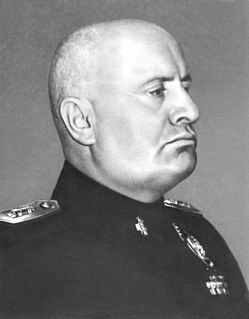The Manifesto of the Italian Fasci of Combat, commonly known as the Fascist Manifesto, was the initial declaration of the political stance of the Fasci Italiani di Combattimento the movement founded in Milan by Benito Mussolini in 1919 and an early exponent of Fascism. The Manifesto was authored by national syndicalist Alceste De Ambris and the futurist poet Filippo Marinetti.
Fernando Mezzasoma was an Italian fascist journalist and political figure.

Carlo Alberto Biggini was an Italian fascist politician who served as Minister of Education before and after proclamation of the Italian Social Republic under Benito Mussolini.

The March on Rome was an organized mass demonstration in October 1922, which resulted in Benito Mussolini's National Fascist Party ascending to power in the Kingdom of Italy. In late October 1922, Fascist Party leaders planned an insurrection, to take place on 28 October. When fascist troops entered Rome, Prime Minister Luigi Facta wished to declare a state of siege, but this was overruled by King Victor Emmanuel III. On the following day, 29 October 1922, the King appointed Mussolini as Prime Minister, thereby transferring political power to the fascists without armed conflict.

Michele Bianchi was an Italian revolutionary syndicalist leader who took a position in the Unione Italiana del Lavoro (UIL) He was among the founding members of the Fascist movement. He was widely seen as the dominant leader of the leftist, syndicalist wing of the National Fascist Party. He took an active role in the "interventionist left" where he "espoused an alliance between nationalism and syndicalism." He was one of the most influential politicians of the regime before his succumbing to tuberculosis in 1930. He was also one of the grand architects behind the "Great List" which secured the parliamentary majority in favor of the fascists.
Fascio is an Italian word literally meaning "a bundle" or "a sheaf", and figuratively "league", and which was used in the late 19th century to refer to political groups of many different orientations. A number of nationalist fasci later evolved into the 20th century Fasci movement, which became known as fascism.

The Chamber of Deputies is a house of the bicameral Parliament of Italy. The two houses together form a perfect bicameral system, meaning they perform identical functions, but do so separately. Pursuant to article 56 of the Italian Constitution, the Chamber of Deputies has 630 seats, of which 618 are elected from Italian constituencies, and 12 from Italian citizens living abroad. Deputies are styled The Honourable and meet at Palazzo Montecitorio. The Chamber and the parliamentary system of the Italian Republic and under the previous Kingdom of Italy is a continuation of the traditions and procedures of the Parliament and Chamber of Deputies as established under King Charles Albert (1798–1849), during the Revolutions of 1848, and his son Victor Emmanuel II (1820–1878) of the Kingdom of Sardinia-Piedmont which led in the "Italian unification Risorgimento movement" of the 1850s and 1860s, under the leadership of then-Prime Minister Count Camillo Benso of Cavour.

Giacomo Acerbo, Baron of Aterno was an Italian economist and Fascist politician who drafted the Acerbo Law which solidified Benito Mussolini's position once in power.
Domenico Pellegrini Giampietro was an Italian academic, economist, lawyer, politician, and journalist.

Giovanni Giuriati was an Italian fascist politician.
Edoardo Alfieri was an Italian fascist politician and diplomat.

Augusto Turati was an Italian journalist and Fascist politician.

Leonilde Iotti, commonly known as Nilde Iotti was an Italian politician, member of the Italian Communist Party (PCI). She was the first woman ever to become President of the Chamber of Deputies, an office who held for three consecutive legislatures from 1979 to 1992, becoming the longest-serving post-war President of the Chamber.

The Italian Fasci of Combat, until 1919 called Fasci of Revolutionary Action, was an Italian fascio organization, created by Benito Mussolini in 1914.

General elections were held in Italy on 26 March 1934. At the time, the country was a single-party state with the National Fascist Party (PNF) as the only legally permitted party.
Sansepolcrismo is a term used to refer to the movement led by Benito Mussolini that preceded Fascism. The Sansepolcrismo takes its name from the rally organized by Mussolini at Piazza San Sepolcro in Milan on March 23, 1919, where he proclaimed the principles of Fasci Italiani di Combattimento, and then published them in the newspaper he co-founded, Il Popolo d'Italia, on June 6, 1919.

The Italian Parliament (1928–1939) was the parliament of Italy as it existed following the constitutional reforms enacted after the Italian general election, 1924. It was, in turn, substantially restructured in 1939. This early Fascist-era legislature was a continuation of the bicameral parliament that had existed prior to 1928, though the character, structure and responsibilities of each house were altered to various degrees.
The National Council of Corporations was a constitutional organ of the Kingdom of Italy between 1930 and 1943.
Events from the year 1921 in Italy.














